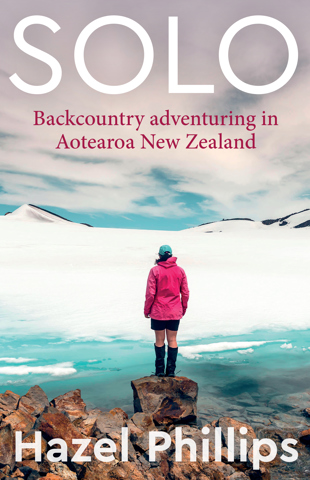Carolyn Enting has reviewed Solo: Backcountry adventuring in Aotearoa New Zealand, the new book by Hazel Phillips on her three years’ adventuring in the Aotearoa wilderness, for Good magazine:
’Hazel Phillips’ first-hand account of backcountry adventuring in Aotearoa ‘solo’ will inspire you to pull your big girl panties on, as well as tramping boots, and get exploring — thought I must admit I devoured her book Solo — a thoroughly riveting read — in two and a half days from the comfort of a hammock.
And I was truly sorry when it ended. I could have kept walking, in my mind at least, with Hazel all over the country and along many of the trails I’ve secretly longed to do but been too “chicken” to try.
It was therefore heartening and encouraging to read her honest accounts about “feeling chicken on multiple occasions and how she subsequently found her confidence and her way, but I won’t give the ending away.
Coincidentally, I was a nano-part in her dramatic first solo ascent and descent of Mt Ruapehu, which gets an upfront mention. The day she slips on slushy snow covering ice on the crater face, sliding a terrifying 100 metres — I remember that day well!
That weekend, my friend Cathy and I were guests of Hazel at her ski club in Whakapapa. Saturday morning delivered the perfect conditions for a solo climbing mission, she said.
I was worried about her doing it solo but had faith that she knew what she was doing. Hazel is no dummy.
So instead of skiing she opted for crampons, and we arranged to wait for her at the mountain café after the last run of the day.
When she finally appeared, we were both aghast and awestruck as a rather shaken Hazel recounted how she’d frantically self-arrested during an estimated 100-metre unplanned slide down the mountain, which she successfully countered. It was also the first time I had heard the term “self-arrest”, which is the technique of stopping an unplanned slide with an ice axe.
Not surprisingly, we didn’t see much of Hazel after that. To say her body was sore and bruised would be an understatement. She didn’t come out to socialise that evening and skipped any physical activities the following day, declining to join our toddle to Taranaki Falls.
Reading her book, I realise this was the beginning of what ultimately led to an extraordinary three years of almost continuous “mostly solo” climbing expeditions for Hazel and her journey to get there is inspiring.
In days gone by, a media review might have described her as “plucky”, but would that term ever be applied to a man? No. as she rightly writes, “nobody raises an eyebrow at men in the wilderness”, and she’s raised a few eyebrows.
One of the many things she has achieved with Solo is turning a passion into a page-turning epic read that also tackles feminism and its intersection with mountaineering.
It also includes dripping historical accounts of women and men who have made their mark in New Zealand mountaineering history through their conquests, including Freda du Faur, the first woman to climb Aoraki / Mt Cook in 1910 — and in a skirt, which convention decreed, though she scandalously shortened it as any sensible person would do — and Samuel Turner, an unapologetic egotist who was first to solo the same mountain.
Solo is also filled with stories of the untimely deaths of unfortunate trampers in the mountains, often as the result of miscalculations or unlucky circumstances that the wilderness can sometimes deliver.
Personally, I’m frightened of river crossings, so reading Hazel’s accounts of these definitely gave me “the wobbles”. To use another Hazel neologism.
I truly admire Hazel’s conviction and courage to push past the wobbles to follow her truth and challenge herself.
Not long after our ski trip, I was invited to join Hazel and Cathy on an “easy” overnight tramp, but it had two river crossings, so I chickened out and made my excuses.
In Hazel’s own words: “For me a big part of the joy of tramping is attempting to do things you think might be (too) hard. If you’re lured by challenge, it can be tough to find people who want to do the same sort of masochistic caper you’re angling at . . . Sometimes it is easier to plan only on yourself.”
Now I wonder, what if I’d gone on that hike with Hazel? Would I be hiking now instead of swinging in a hammock?
What I do know is that I have thoroughly enjoyed accompanying Hazel’s “solo” journeys to all these places and thank her for bringing the mountains and their remote huts closer.’


